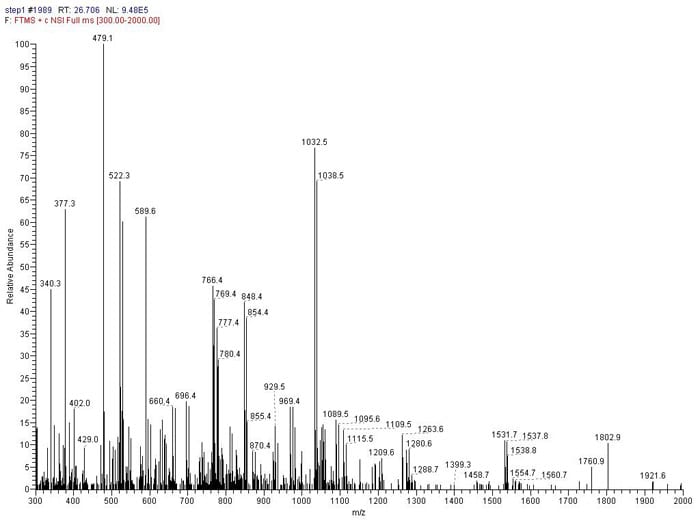Nanoscale LC MS/MS using CID, HCD or ETD fragmentation allows the identification of individual peptides from a complex mixture. This is a powerful proteomics technique through which the component proteins in a sample can be identified.
Typically, a sample is prepared by tryptic digestion and desalting of a protein mixture obtained in the course of the users’ research. Samples have varied in complexity from purified protein complexes to whole cell extracts.
We load desalted, proteolysed mixture on a nanoscale HPLC column. These columns employ either reverse phase (1-dimensional) or a combination of ion exchange and reverse phase (2-dimensional or mudPIT) separation chemistries. The eluent from the LC column is subjected directly to tandem mass spectrometry, and the mass and fragmentation spectrum of major ions is recorded.
A computer program suite is then used to identify the peptides that gave the spectra that have been collected. It queries a sequence database for the appropriate organism, calculating theoretical fragmentation spectra for all possible peptides and comparing them to the data collected.
The final output for the user is a file listing each gene for which peptides were found in the data. Each peptide is listed along with statistics showing the quality of the data.
One dimensional separations are appropriate for samples where the expected complexity is 1 to 10 proteins. Between 10 ng and 500 ng are needed for the analysis.
Two dimensional “MudPIT” separations are appropriate for more complex mixtures. Between 100 ng and 10 ug are needed for analysis.
Users generally prepare a proteolysed, desalted sample for one dimensional or two dimensional analysis.
To perform this type of analysis, please refer to the following forms and protocols:
Lys-C or trypsin in-solution protein digest protocol
From the J. Yates Lab, Scripps Research Institute
This protocol can be adapted to use other proteases. Change the buffer from Tris to one that can
give a pH appropriate for the desired protease, then follow the trypsin directions.
1. Bring solution up to 8M Urea and 100mM Tris-HCl pH 8.5 (use 10 M urea and 1 M tris
stocks; ideal final volume is about 80μl).
2. Add 100 mM TCEP (a reducing agent) to a final concentration of 5 mM. Incubate at room
temp. for 20 min.
3. Add 500mM iodoacetamide (make fresh daily) to a final concentration of 10 mM. Incubate
at room temp. for 15 min. in the dark (covered with foil).
4. Use one of the following enzymes:
Lys-C Digest:
1. Add in Lyse-C 1μl (0.1μg/μl), 1/100th total amount.
2. Incubate for 4 hr. at 37°C in the dark.
Trypsin Digest:
1. Dilute samples by a factor of four with 100mM Tris-HCl pH 8.5 (final urea conc. = 2M)
2. Add 100 mM CaCl2 to a final conc. of 1mM.
3. Add in trypsin 1μl (0.5μg/μl)
4. Incubate overnight at 37°C in the dark.
5. Add formic acid to 5% final concentration. Use only glass pipets for adding concentrated
formic acid.
Solutions:
1M TCEP
for 1ml:
287mg
1ml MilliQ water
make a 1/10 dilution and store at –20°C in aliquots
500mM iodoacetamide
for 0.5ml:
46mg
500μl ddH2O, make fresh
1M CaCl2
for 100ml:
14.7g CaCl2•2H2O
ddH2 O to 100ml
Sample desalting for mass spectrometry
Equipment:
C18 Spec tips, Agilent, cat #A57203
p200 and p1000 pipetmen
You can use a p1000 pipetman to wash and elute spec tips. For each wash, add the
required volume into the top of the spec tip, then press a p1000 tip firmly into the spec tip
and depress the plunger to drive the liquid through the device.
1. Wet the spec tip by pushing through 200 μl of HPLC grade methanol.
2. Wash the spec tip with 3 x 200μl 5% acetonitrile/5% formic acid.
3. If your sample does not already contain an acidic ion pairing agent, add formic
acid to your sample to 5%. NOTE: Do not pipet concentrated formic acid with
plastic pipet tips; use glass.
4. Push the sample through the spec tip. You may pass the sample through twice,
washing with 5% acetoniltrile/5% formic acid between each pass, if you would
like to maximize binding.
5. Wash with 3 x 200 μl 5% acetonitrile/ 5% formic acid.
6. Elute with 2 x 100 μl 80% acetonitrile/5% formic acid.
7. Speed vac the sample to dryness.
Reagents:
HPLC grade methanol
5% HPLC grade acetonitrile/5% formic acid
80% HPLC grade acetonitrile/5% formic acid
Make solutions with MilliQ or better water. NOTE: Do not pipet concentrated formic
acid with plastic pipet tips; use glass.
We urge you to contact facility staff to discuss your project prior to sample preparation.
